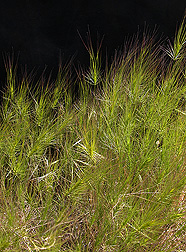This page has been archived and is being provided for reference purposes only. The page is no longer being updated, and therefore, links on the page may be invalid.
Read the magazine story to find out more. |
|
Managing the Medusahead Weed
By Laura McGinnisJuly 24, 2007
Aggressive and unruly, the invasive weed medusahead covers millions of acres in the Pacific Northwest. Fortunately, new research from Agricultural Research Service (ARS) scientists is helping landowners tame this pesky weed.
Medusahead is 11 to 15 percent silica--a gritty mineral that wears away at teeth--compared to the 1 to 3 percent found in most grasses. It rapidly replaces native plants and significantly reduces the grazing suitability of the land it overruns.
Most grazing animals find it unpalatable. Animals that try to reach the few edible plants that aren't edged out by the weed risk injuring themselves on its spiky awns, the bristly crowns whose sharp spirals give medusahead its distinctive name.
In 2003, ARS ecologist Roger L. Sheley spearheaded the "Medusahead Challenge," a program involving about 130 landowners and range managers from the western United States. Sheley works in ARS' Range and Meadow Forage Management Research Unit in Burns, Ore.
Sheley's program teaches participants to recognize the causes underlying changes within plant communities and plan effective management strategies for their property. So far, the program has helped establish medusahead prevention plans for about 150,000 acres in the region. An additional 20,000 acres are already under management.
In a related study, Sheley is testing several ecological management theories to see if they can be practically applied to the Great Basin and Columbia Plateau, where medusahead is a serious problem.
For example, the Burns scientists have studied the consequences of range restoration techniques such as disking, a management method that involves slicing into the soil to break up root systems and allow competing vegetation to thrive. But disking disturbs the soil, creating a nitrogen-rich environment that could easily be exploited by rapidly growing weeds. The scientists recommend minimizing soil disturbance and lowering the nitrogen quickly so that native species can flourish.
Recommendations like this have helped land managers establish invasion-resistant plant communities in localized areas within the region.
Read more about the research in the July 2007 issue of Agricultural Research magazine.
ARS is the U.S. Department of Agriculture's chief scientific research agency.

